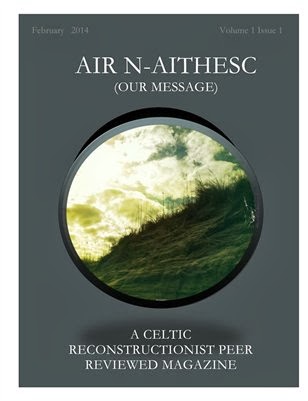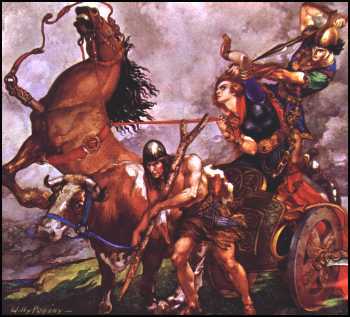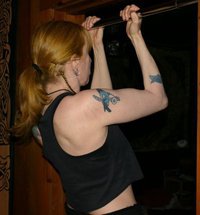 If you find this article helpful, please remember this was work to put together and I have animals to feed and vet
If you find this article helpful, please remember this was work to put together and I have animals to feed and vet
Those of us who follow an Morrígan are in an interesting position compared to many Gaelic Polytheists. We actually have an example of a patron/client relationship between a Deity and a human (albeit a human with divine paternity, sort of). It is, of course, through Christian eyes that we get it, so many dismiss this all together. This is particularly true as this warrior, Cú Chulainn, often offends the sensibilities of many who claim to be devoted to Her and on the warrior path.
There are many issues, really, but right now I want to concentrate on aspects of the relationship between CC and the Morrígan which I feel are widely misunderstood. The problem is that without looking at some of the issues from a warrior perspective, including by people who claim to be warriors, and with an understanding of certain elements of Irish culture, it can be read in a very different way from what it may have meant to early warriors who may have heard and orally shared the stories. Some of the scribes who wrote them down, also not being warriors, may well have considered them much as we do today, yet the actual stories seem to give a different read when taken from a warrior perspective.
The reading that many in the Pagan community, from the “fluffiest of fluffies” to the “hardest core Reconstructionists,” give the relationship is that CC is rude, arrogant and offensive to the Morrígan. And it can appear so. Even form the earliest encounters as a boy, when She mocks him as unable to fight a phantom, which he then does defeat.(TBC Rec I, pg. 16, 139) It seems there that She doesn’t like him much, but consider then what that means that CC actually orders his charioteer to mock him at a later point.(TBC Rec I, pg. 93, 207) At some point I hope to further explore gressacht, inciting by ridicule, something which is very difficult to understand in a culture where it would be mistaken for bullying which is meant to crush us.(MacCana)
The biggest confusion comes from his response to Her in Táin Bó Cúailnge Rec I, when she comes to him and offers him Sex in the middle of his standoff at the ford. This tale actually does not appear in all of the versions of the TBC and I hope to explore the events in the Táin Bó Regamna (Edit: and I did in Part 2) which also serves to set up the same events at a later time. (I have explored both somewhat already in, “Musings on the Irish War Goddesses” publication pending) Both of these do, after all, seem to get heavily misread.
The reading of this version is that he spurns Her offer of “love” and She, being female and therefore only able to resort to revenge when crushed in this way, punishes him by coming against him while he’s in battle. Some of these retellings of the meeting between CC and the Morrígan make Her out to be a truly pathetic woman we are supposed to feel sorry for while others point what a mistake it is to refuse such a powerful Goddess…some manage to take both these directions at once. It is used by several “warriors” to show why one does not refuse the demands of the Goddess, ever (in what appears to be an attempt to excuse their own recent actions).
This is a translation of the exchange in question:
Cú Chulainn saw coming towards him a young woman of surpassing beauty, clad in clothes of many colours. ‘Who are you?’ asked Cú Chulainn. ‘I am the daughter of Búan the king,’ said she. ‘I have come to you for I fell in love with you on hearing your fame, and I have brought with me my treasures and my cattle.’
‘It is not a good time at which you have come to us, that is, our condition is ill, we are starving (?). So it is not easy for me to meet a woman while I am in this strife.’ ‘I shall help you in it.’ ‘It is not for a woman’s body that I have come.’
‘It will be worse for you’, said she, ‘when I go against you as you are fighting your enemies. I shall go in the form of an eel under your feet in the ford so that you shall fall.’ ‘I prefer that to the king’s daughter,’ said he. ‘I shall seize you between my toes so that your ribs are crushed and you shall suffer that blemish until you get a judgment blessing.’ ‘I shall drive the cattle over the ford to you while I am in the form of a grey she-wolf.’ ‘I shall throw a stone at you from my sling so and smash your eye in your head, and you shall suffer from that blemish until you get a judgment blessing.’ ‘I shall come to you in the guise of a hornless red heifer in front of the cattle and they will rush upon you at many fords and pools yet you will not see me in front of you.’ ‘I shall cast a stone at you,’ said he, ‘so that your legs will break under you, and you shall suffer thus until you get a judgment blessing.’ Whereupon she left him (Cecile O’Rahilly, trans. Táin Bó Cúalnge, Recession 1 Dublin: Dublin Institute for Advanced Studies, 1976 English pg. 177, Irish pg. 37)
At face value, taken as a modern story, the reading given does seem obvious. It appears She comes in disguise, however, even in doing so Her role is very clear. Epstein notes that She clearly reveals Herself as a Sovereignty/Victory Goddess when She offers help in his battle. (Epstein, sorry due to mangled formatting I have no page number) Yet there seems at least some hint in calling Herself the daughter of King Búan. A king’s daughter to make a king, Búan linked to “Búanann” a name related to Anann and therefore the Morrígan.(O’Donavan, pg. 17, Epstein) She does indeed say She loves him…for his fame. Which many others did as well, but given context, it could serve as a reminder that, indeed, the glory he has sought since childhood is why She is there.
Certainly, She does say, “It will be worse for you when I go against you as you are fighting your enemies.” So that must mean She’s angry and is going to retaliate. Right? Say “no” to this Goddess is a foolish thing. Because Cú Chulainn’s life was horrible and hard and we’d never want what he had. Wait? What?
No, let’s look at what is She really offering and what is he rejecting? She is saying She is offering love and, obviously, sex. Yet even those mistaking this for a story of scorn love realize that this is also about offering victory as She offered Dagda in the Cath Maige Tuired. (CMT, para. 84) Of course, many seem to think of that as a love story as well, rather than the powerful rite that it was. Dagda accepts and while the victory is not easy, it is had. Cú Chulainn refuses, the Morrígan is hurt and refuses him victory and he is destr…..oh, wait.
I realize this may be really hard for people to grasp. But Cú Chulainn does win. But it’s not easy. And She does make it harder. But was that punishment? Really?
Let’s compare what is different about CC and Dagda for a moment. Dagda is a God, an equal in all ways to the Morrígan. He is an established warrior among the Tuatha Dé Danann and has even been king. He has His own magic, again well established. Mostly, He has nothing to prove.
Cú Chulainn as a boy took up arms when he heard it was a good hour to do so to live a glorious life and die
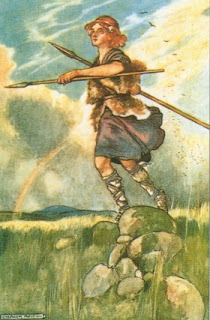 |
The boy Cú Chulainn
by Stephen Reid
1912 |
young and famous. He had by this time proven himself many times yet was always challenged for his youth and strangeness. He was still a youth and this was, in fact, the story which would make that fame if he was to have it. While other exploits contributed, this was the story which marked him. He still had to fight it.
So let us think what the Morrígan was doing here, actually doing here.
Let’s think that all evidence we have. She does love him.. If we try to understand the gressacht for what it is and we realize that at his death She is distraught and is not Cailitín’s daughter who is also, confusingly, called Badb, who facilitates his death. Rather She tries, despite obviously knowing it’s futile to prevent it. (Van Hamel, pg. 69-133, O’Grady and Stokes in Hull, pg. 235-263) this becomes clear. And She does love him for his fame or rather his determination to have it. And that is important.
What she is offering, by offering him to lie with Sovereignty/Victory, is to lose that all. Think. Go beyond what you think is good or bad, is reward or punishment and think what he had wanted. And think what laying with Victory would give.
What she offered was an easy victory during the events which would mark his fame. He clearly knew who She was and what that would mean. He would have won easily, there would be no tale to tell, he would have been at best a side note but possibly totally forgotten. We’d have no stories today.
ETA: I should also note, that She’d have turned from him, as well. He’d be forgotten for he’d never do anything of note. He’d be no champion and his people would be left without.
This is called a test. She did not want him to say “yes.” If he had then he’d undoubtedly have been punished. He’d have won easily and been forgotten. The worse punishment there could have been for him.
The punishment you see, that She comes against him while he is in battle, serves to further his fame. A fight that is “worse” means winning is better. For he not only faced a warrior but the War Goddess in battle. Do you really believe that She is so weak he would have won against Her if that wasn’t the point? Then why worship such a weak Goddess?
That, btw, is something that boggles me. Especially, among those who then claim “well, She showed him not to say “no” to her!” Um, he won. Is this the extent of strength you see in your Goddess? That She’d try to fight him for real and failed? Then you claim you are afraid to say “no” to Her? What sort of wimp are you then?
Instead, I believe She acts to show Her chosen favorite is indeed mighty! Rather than an easy and easily forgotten victory, She gives him a harder one, one that let’s him rise above all! Because he knew to say “no” to Her test.
She then offers him milk, again in “disguise” which must clearly have been evident. A three teated cow in the presence of an old woman doesn’t add up to a Goddess of cattle? In this She gives him fame for the other side of war, that he also can heal, even a Goddess.
Think. What is punishment to a warrior who as a very small child declared he wanted to have a glorious, famous short life? Why, it would be to have forgotten long one.
And if one thinks a forgotten life is better if you live safely into old age, are you ready to walk the warrior path? None of us are Cú Chulainn, but if you choose a safe life and easy victories, if you choose to say “yes” when ever She tests you to see how much you want what you claim you want then you are far from following his way.
This is a lesson we must learn, that She will ask of us things that go against what we know deep down in our hearts is the right way. She will ask us to do things which She does not want us to do. To serve the Morrígan one needs to have the courage to say “no.” While there are many ways that Cú Chulainn might be a problematic role model, showing the importance of passing such tests is not one of them. He shows us well. Act in accordance to your heart when the Phantom Queen tests you and it will serve you well. Even if the weak can never understand.
See also:
The Morrígan and Cú Chulainn pt. 2: Insult and Praise as Incitement
The Morrígan and Cú Chulainn pt. 3: Of death and dog meat
I also discuss some of this, as well as expand on the nature of the Morrígan “Musings on the Irish War Goddesses” in By Blood, Bone and Blade: A Tribute to the Morrígan Nicole Bonivusto, ed, Ashville, NC: Bibliotheca Alexandrina, 2014
Bibliography
Angelique Gulermovich Epstein, “War Goddess: The Morrígan and her Germano-Celtic Counterparts” dissertation, University of California in Los Angeles, 1998
Elizabeth Gray, trans. Cath Maige Tuired: The Second Battle of Mag Tuired Dublin: Irish Text Society, Irish English
Eleanor Hull, ed., The Cuchullin Saga in Irish Literature: being a collection of stories relating to the Hero Cuchullin, London: David Nutt on the Strand, 1898 (Hayes O’Grady, trans., “The Great Defeat on the Plain of Muirthemne before Cuchullin’s Death” and Whitley Stokes, trans., “The Tragical Death of Cochulainn,)
Proinsias MacCana, “Láided, Gressacht ‘Formalized Incitement’” Érui vol. 43
Kuno Meyer, trans. ‘The Wooing of Emer’“Tochmarc Emire,” Archaeological Review 1, 1888, Irish English
John O’Donovan, ed. and trans. (with notes and translations from Whitley Stokes) Sanas Cormaic Calcutta: O. T. Cutter for the Irish Archeological and Celtic Society, 1868,
Cecile O’Rahilly, trans. Táin Bó Cúalnge, Recession 1 Dublin: Dublin Institute for Advanced Studies, 1976 Irish English
AG van Hamel Compert Con Culainn and Other Stories, Medieval and Modern Irish Series, Vol 3, Dublin: Dublin Institute for Advanced Studies, 1933
Copyright © 2013 Saigh Kym Lambert
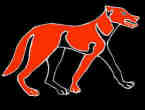 The next issue should be out at Imbolc, in just a few weeks. I will try to post excerpts in a more timely manner at that point. ~;) Or maybe I’ll even blog something else. ~:p
The next issue should be out at Imbolc, in just a few weeks. I will try to post excerpts in a more timely manner at that point. ~;) Or maybe I’ll even blog something else. ~:p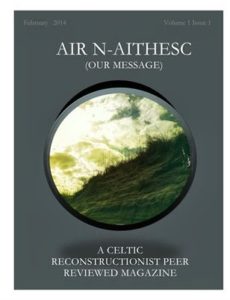
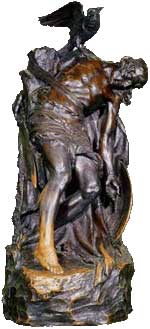

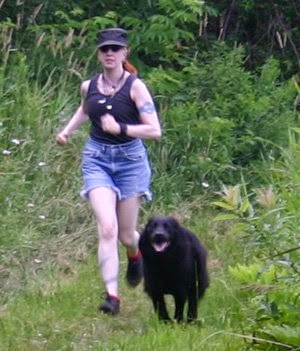 things out, should have left things out, want to word things differently, add links and what not. I did take some of the material from the bottom of the warrior path page to the beginning of the new page and also reworked some of the historical material on the
things out, should have left things out, want to word things differently, add links and what not. I did take some of the material from the bottom of the warrior path page to the beginning of the new page and also reworked some of the historical material on the